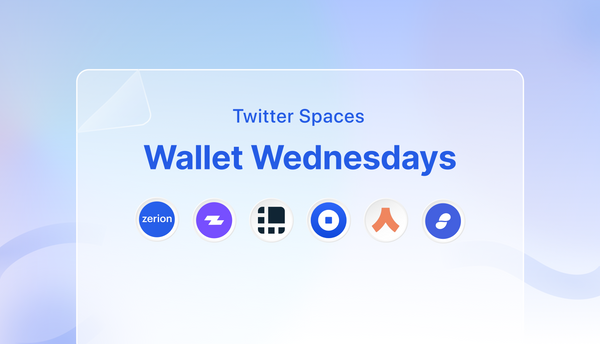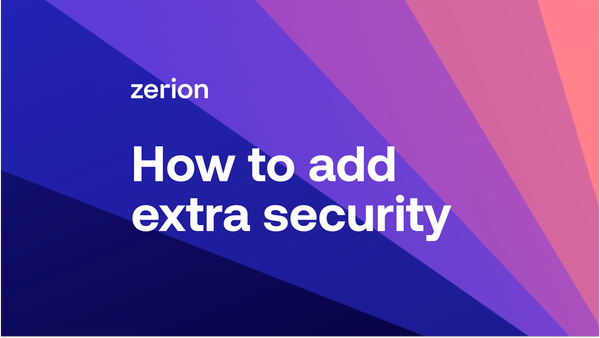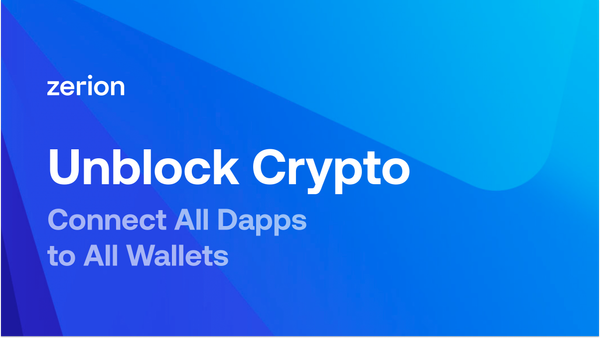Any Web3 adventure starts with a non-custodial wallet.
To access DeFi, NFTs, and DAOs, people need tools that make these new experiences as easy as possible.
We recently launched Wallet Wednesdays — a series of Twitter Spaces aimed at improving public dialogue around web3 wallets. What are they? What should they be? And what questions do we ask ourselves to improve where they go?
We're bringing together thought leaders and builders pioneering the next frontier of web3 UX. These speakers helped kicked off our first session:
- Rebecca Mqamelo, Head of Growth at Zerion
- Evgeny Yurtaev, CEO at Zerion
- Fatima Khaziyeva, Product Manager at Zapper
- Carl Fairclough, Senior Product Designer-Owner at Status
- Charles Hamel, VP Product at Ledger
- Matt Marshall, Engineering Lead at Argent
- Chintan Turakhia, Director Of Engineering at Coinbase Wallet
- Oops, Community Wizard at Zapper
What is a web3 wallet and why is it important?
The discussion kicked off with asking this simple question: What exactly is a Web3 wallet?
Most of us are familiar with using browser extensions like MetaMask which limits our exploration of web3 to a desktop experience. But this is evolving.
Carl Fairclough of Status pointed out that this shift focus is largely driven from developers to users:
Different waves have come and gone. It started with thinking about how developers interact with blockchains to build out products and a lot of those patterns really stuck around, especially when it comes to network switching.
User expectations have also evolved. People now want wallets to double as an interface where you can view everything. A crypto wallet is no longer only a tool that you're using to sign transactions.
Yet first people need to understand why they need a self-custody wallet, Chintan Turakhia from Coinbase noted:
Most folks are aware that coinbase.com is the centralized exchange. So many users in fact think they already have a wallet. We need to provide education for folks so they understand there's a big difference between fully custodial and self custody
Charles Hamel, VP Product at Ledger, added that the way wallets are used has also changed a lot:
The wallet was the destination when you wanted to interact with these networks. Whereas now with web3 in a post-2021 world, the destination is a dapp [decentralized app]. It's a website, it's a content page and the wallet comes in and augments this experience. It’s for transacting, for signing, for authentication, for login. The wallet is not so much a destination but more like an augmentation layer, where you can bring your own keys and interact with web3."
Better wallets welcome new people to web3
As new people are entering the crypto space, approaches to wallet security are also changing.
Argent in particular has a novel approach to security with social elements, Matt Marshall explained:
We started with the premise that we couldn't have a world where losing a secret phrase means losing all of your money. And with that in mind, we came up with the concept of social recovery, where guardians can form part of your recovery mechanism using multisig transaction signing.
Obviously, we're mobile-first as a product and we believe that to get web3 and self custody mainstream we need to be able to look at not just the technical security side, but also the social interactions and social attack vectors which are possible.
Many speakers also highlighted the importance of education for new users.
Fatima Khaziyeva elaborated on Zapper’s approach:
We know that in the next few years some users will never use a bank to take out a loan out and so they will only know the DeFi experience. And knowing that, we want to make sure they have the right experience when they onboard into web3. The way we've been approaching this is really from a complete user journey and UX perspective, so not only from a wallet perspective.
Wallet composability: 1Password for crypto?
People who are already in crypto probably have several wallets. For example, you might have a Ledger hardware wallet for larger long-term holding. Another wallet might help you easily trade across different chains. This increases the importance of wallet composability: managing several wallets at the same time.
Zerion’s CEO Evgeny Yurtaev suggested this simple metaphor:
One idea we've been thinking about is a "1Password" for all of your private keys. Think of an app that acts like a single guardian for multiple private keys that you hold across different applications.
Mobile-first wallets: Web3 on your phone
All speakers agreed on the importance of a mobile-first experience for crypto wallet management.
Oops, Community Wizard at Zapper, introduced some numbers to highlight the importance of mobile UX:
For the Zapper Discord community, 23% are mobile-only. Zapper actually has one of the lowest rates in that category. The highest I saw was a group called Bananacoin. 45% of their community is mobile-only. A lot of people like my parents, for example, use iPads and they don't have a desktop.
Crypto becomes very challenging for these people. It's much harder on iOS than it is on Android. There's been much more attention to detail on the Android side in terms of like what you can do without, like the App Store blocking your in-app transactions and having exchanges built into your app.
If at least one quarter of the community is mobile-only, we need to start accounting for those people more.
This is even more important in markets like the Philippines, Vietnam, and Thailand, Chintan Turakhia of Coinbase added.
Gaming is also a big part of what excites users, the play-to-earn experiences in web3. And a lot of that is done on mobile, which is great. But if you shift over into the US, most of us are probably on our desktops.
Web3 wallets must be multichain
Over the past years, the number of chains has exploded, including alternative Layer 1 networks that compete with Ethereum and Layer2 scaling solutions. Speakers explained their strategies for dealing with this increasing complexity.
Chintan Turakhia outlined Coinbase’s current approach:
At the core, we support all EVM compatible chains and as well as mainnet: Avalanche, Arbitrum, Optimism, BSC, Fantom, etc. We just recently also announced support for Solana.
We try to keep a pulse on what's going on out there. Where is trading volume going? Where are users going? And also, just as importantly: how are these chains bringing users into web3 in a safe and secure way? There are other really great protocols and chains out there such as Terra. But I think one of the hard parts is that some chains require a significant amount of overhaul.
While now all chains are used in similar ways and DeFi is essentially the same on all chains, this might change, Matt Marshall suggested:
There are use cases we don't know about yet. So we want to make sure that we don't limit access longer-term and that people have the widest ability in experience different products which are being built on different chains.
What’s next for Wallet Wednesdays
Stay tuned for our next Wallet Wednesdays on 30 March 2021 at 8 AM PST. We'll focus on lessons learned in building wallets: user research and collaborative building with the community.




